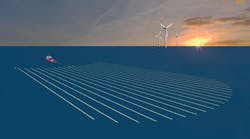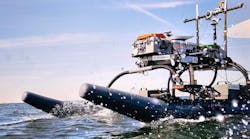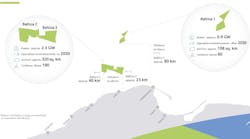Offshore staff
DUBLIN, Ireland – Providence Resources has issued an update on its analysis of deepwater frontier exploration license (FEL) 2/14 in the southern Porcupine basin offshore Ireland.
FEL 2/14 is in 2,500 m (8,202 ft) of water, 220 km (137 mi) off the west coast. Providence operates in partnership with Sosina Exploration.
The license is roughly 70 km (43 mi) southwest of the ExxonMobil-operated 44/23-1 Dunquin North exploration well drilled in 2013, which encountered a 44-m (144-ft) residual oil column in lower Cretaceous carbonates.
Providence’s assessment of the Paleocene section within FEL 2/14, using Polarcus’ newly acquired 3D seismic reflection data, confirms the presence of a 400-sq km (154-sq mi) deepwater fan system named Druid. This had also been apparent on previous 2D long-offset seismic profiles.
Druid is the second large prospect to be identified in the license after the lower Cretaceous Drombeg, which could hold prospective resources of 1,050 Bboe recoverable.
The new 3D data have improved imaging of the internal depositional architecture within the Druid fan system, suggesting it has been sourced from the Porcupine Bank to the northwest.
The central 60 sq km (23 sq mi) of the fan system exhibits distinct seismic morphologies previously modeled to be consistent with a thick, high-porosity and shallow-lying sandstone reservoir system.
This mounded central section of the fan exhibits a Class II AVO anomaly that appears to be terminated up-dip by an erosive intra-fan channel.
Providence adds that the anomaly also to be associated with a fluid escape feature from an underlying deeply buried pre-Cretaceous rotated fault block suggesting it may be a direct hydrocarbon indicator.
In 1988, Amoco reported light tan oil bleeding from a Paleocene deepwater sandstone core taken from the 35/18-1 well in what is now Cairn-operated FEL 1/14, 190 km (118 mi) east-northeast of Druid.
John O’Sullivan, Providence’s technical director, said: “These initial 3D seismic observations at Druid are very encouraging given the considerable Palaeocene exploration success that the neighboring UK west of Shetlands has enjoyed using similar 3D seismic imaging and attribute analysis.
“We have witnessed a step change uplift in the imaging of the Druid fan system versus the previous 2D seismic data interpretation which now allows us to subdivide the fan into various sediment pulses and better understand potential reservoir sweet spots and intra-fan trapping morphologies which could be targeted with a future exploration well. Further work is ongoing which will ultimately include an estimate of Druid’s prospective resource potential.”
06/10/2015




